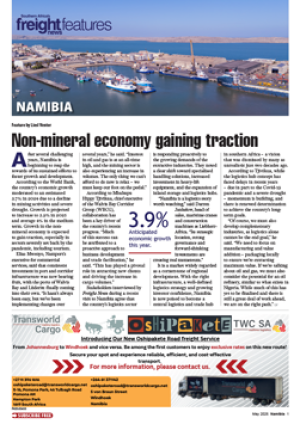With the July 1 deadline
looming ever closer, shippers
have been warned that
the compulsory container weighing
guidelines and
regulations are a lot more
complicated than most people
were thinking.
“A whole host of issues has
arisen surrounding how a
‘shipper’ can be guaranteed
to have legally declared the
‘verified gross mass (VGM)’
of his container of cargo and
complied with the demands of
the International Convention
for the Safety of Life at Sea
(Solas) Chapter vi, Part A,
regulation 2,” Peter Lamb,
zsenior associate with the
legal firm Norton Rose
Fulbright in SA, told FTW.
These complications arise
when trying to answer the
simple question: Containers
and trucks: Who must weigh
what, when and where?
First off, the definition
of the term ‘shipper’ is
“astonishingly broad” says
Lamb, suggesting it could well
include freight forwarders,
container operators,
consolidators and the like –
and not just the party with an
interest (risk or ownership) in
the containerised goods.
And, although shippers
have always had to declare
an accurate gross mass of
a container on the bill of
lading under the Merchant
Shipping Regulations, the
guidelines’ two prescribed
methods of verifying the gross
mass of a packed container
by a ‘certified process’ are
brand new. Also new is the
mandatory prohibition on
carriers not to load containers
without VGM.
You can weigh a full
container and contents
– which would require a
weighbridge. Or you can
weigh all packages, pallets,
dunnage and packing and
securing material separately
(on approved scales, for
example), and add the tare
weight of the container to the
sum.
Now, according to Lamb,
if the shipper is dealing
with ‘individual, original
sealed packages that have an
accurate mass of the packages
and cargo items clearly and
permanently marked on their
surfaces’, then the shipper will
not need to re-weigh them.
“However,” he said, “it is not
clear whether this exception
is only applicable to cargoes
and packages that have
already been weighed using a
‘certified method’.”
Another problem arises
if the shipper is dealing
with consolidated cargo.
Although the container is
packed by multiple parties or
contains cargo from multiple
parties, Lamb said that the
shipper must still obtain and
document the verified gross
mass of the fully packed
container.
Also, as in many
countries, all weighing
scales have to be certified
and calibrated in terms of
legislation. On the local
front, the SA Maritime
Safety Authority (Samsa)
– the authority responsible
for certifying
and
approving
the method
used – is in
the process
of appointing
third parties
who will
facilitate this
certification.
“But,” said
Lamb, “if
this process is not finalised
by the time the guidelines
come into force, it is most
likely that carriers will still
refuse to receive containers
that do not have a VGM
– as their insurances will
lapse if the carriers load
containers in contravention
of Solas.”
Shippers also get
involved in a selection of
road transport regulations.
“In multi-modal
transport,” Lamb told FTW,
“the shipper is not only
responsible for confirming
the weight of the container
but also the mass of the road
vehicle.”
First off, a consignor is
prohibited from offering
goods if the
vehicle is
not loaded
in terms of
the National
Road Traffic
Act (NRTA),
Regulation
330A(1).
Second,
under
Regulation
330A(4),
he is also
prohibited from concluding
the contract with the road
haulier if the vehicle is
overloaded.
Third, the consignor is
also obliged to keep a record
of the mass of every load
transported from its premises,
under Regulation 330B.
And fourth, the NRTA also
requires that he has a method
of determining the mass of a
vehicle and any axle or axle
unit of such vehicle so as to
ensure that the vehicle axle
or axles are not overloaded,
under Regulation 330B(10).
“In these circumstances,”
said Lamb, “it appears
impractical for a shipper to
rely upon the second method
of determining the gross mass
of a packed container, if he is
already burdened with having
to send the road vehicle over a
weighbridge.”
The final step in the whole
procedure is that the gross
mass of the packed container
must be communicated
in a shipping document
signed by a duly authorised
representative of the shipper.
And the penalties if a
shipper does not comply with
the guidelines?
Said Lamb: “It is
mandatory that the container
cannot be loaded on board a
vessel, with all the problems
this creates.
“In addition, any person
who contravenes the Act
will be guilty of an offence
and upon conviction
will be liable to a fine or
imprisonment for a period
not exceeding one year.”
INSERT & CAPTION
The definition of
the term ‘shipper’ is
astonishingly broad.
– Peter Lamb
.PNG)

